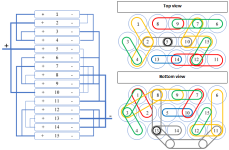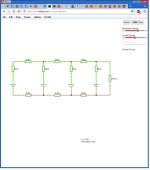tsourorf
1 mW
- Joined
- Jan 29, 2016
- Messages
- 19
As promised, the schemas of my connections:

And the final result on my bike will look like that:

In the first picture, you can see the connections. The positive of the 15P pack will come out of the cell no5 and the negative out of cell no13. In theory, if the motor wants to draw 30A, the gray strips connecting cell no5 to cell no2 and no10 will carry 15A each direction. Then, the yellow strips connection no2 to no1 and no4, as well as the ones connecting no10 to no7 and no15 will carry 7.5A on each branch. etc, etc. You get the idea.
Each 15P pack will be connected in series to the next and also give a small feeback to the BMS for the voltage balancing. The complete triangle pack will have one input at the back for the charger to go to the wall socket as well as one output cable that will reach to the rear bike rack and connect to the motor controller.
As I previously mentioned, I need a material that can cope with the 15A. I don't want the packs to overheat or the cells to get burnt because of the strips.
Any feedback is highly appreciated!

And the final result on my bike will look like that:

In the first picture, you can see the connections. The positive of the 15P pack will come out of the cell no5 and the negative out of cell no13. In theory, if the motor wants to draw 30A, the gray strips connecting cell no5 to cell no2 and no10 will carry 15A each direction. Then, the yellow strips connection no2 to no1 and no4, as well as the ones connecting no10 to no7 and no15 will carry 7.5A on each branch. etc, etc. You get the idea.
Each 15P pack will be connected in series to the next and also give a small feeback to the BMS for the voltage balancing. The complete triangle pack will have one input at the back for the charger to go to the wall socket as well as one output cable that will reach to the rear bike rack and connect to the motor controller.
As I previously mentioned, I need a material that can cope with the 15A. I don't want the packs to overheat or the cells to get burnt because of the strips.
Any feedback is highly appreciated!




